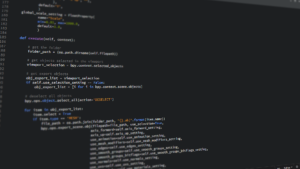In the rapidly evolving landscape of digital finance, the quest for efficiency, security, and user-friendly interfaces has led to significant technological advancements. Among these, Python, a powerful and versatile programming language, has emerged as a cornerstone in the modernization of e-money systems. Its simplicity, readability, and wide range of applications have made it a preferred choice for developers seeking to innovate and streamline online payment solutions. This blog post aims to explore the pivotal role Python plays in the development and enhancement of digital financial services, highlighting its impact on security, transaction processing, and overall user experience in e-money systems.
E-Money License
To operate legally and securely, e-money systems require a specific regulatory framework that encompasses acquiring an e-money license. This license demonstrates a platform's compliance with financial standards and regulations, ensuring the safety and reliability of transactions for users. These can differ from place to place, for example, an EMI license in Lithuania may have different requirements than an EMI license in the United Kingdom. Python, with its vast array of libraries and frameworks, offers solutions for all stages of obtaining an e-money license - from data analysis to compliance management.
Understanding E-Money Systems and Their Evolution
E-money systems have transformed the way we transact, moving us closer to a cashless society. These systems, essentially digital representations of money stored on electronic devices or online, enable the instant transfer of value between individuals or entities over the internet. Their evolution began with simple online transactions and has since expanded into comprehensive platforms that integrate payment processing, online banking, and financial services.
This transformation has been fueled by advancements in technology, consumer demand for convenience, and the global shift towards digitalization. Python has been at the forefront of this evolution, facilitating the development of scalable, secure, and efficient e-money platforms. Its role in automating transaction processes, analyzing financial data, and maintaining security standards has been crucial in the adoption and advancement of e-money systems worldwide.
Advantages of Python for Developing E-Money Solutions
The adoption of Python in the development of e-money solutions brings numerous advantages that directly contribute to their efficiency, security, and scalability. Firstly, Python’s simplicity in syntax and dynamic typing accelerates the development process, allowing developers to implement complex functionalities with fewer lines of code compared to other programming languages. This not only speeds up the initial development phase but also simplifies maintenance and updates over time.
Secondly, Python’s extensive library ecosystem is another significant advantage. Libraries such as NumPy and Pandas facilitate advanced data analysis and manipulation, which is crucial for managing financial transactions. Meanwhile, frameworks like Django and Flask provide robust tools for developing secure web applications efficiently, ensuring that e-money platforms are not just functional but also secure against cyber threats.
Lastly, Python supports cross-platform development, which is essential in today’s digital age where users access e-money services across various devices. This cross-compatibility ensures a seamless user experience, whether the platform operates on web browsers, smartphones, or tablets, broadening the reach and accessibility of e-money services.
Creating Secure and Scalable E-Wallets
In the realm of digital finance, e-wallets represent a significant leap forward, offering users unparalleled convenience in managing their finances. Python's role in creating secure and scalable e-wallets cannot be overstated. By leveraging Python’s capabilities, developers can ensure that these digital wallets not only provide a user-friendly interface but also maintain the highest standards of security and scalability.
Security is paramount in the development of e-wallets. Python’s robust set of security-focused libraries, such as PyCrypto and Cryptography, allows for the implementation of advanced encryption techniques, safeguarding users’ financial data against unauthorized access and cyber-attacks. Additionally, Python's frameworks, like Django, come with built-in security features that help defend against common vulnerabilities such as SQL injection and cross-site scripting (XSS), further enhancing the overall security posture of e-wallet applications.
On the scalability front, Python’s async features and frameworks like FastAPI facilitate the building of e-wallets that can handle a high volume of transactions without compromising on performance. This capability is crucial for maintaining a seamless user experience, especially during peak traffic times. Python's ability to integrate with other technologies and its support for microservices architecture also play a vital role in ensuring that e-wallet platforms can grow and adapt to the changing needs of the market.
In conclusion, Python has become an integral tool in modernizing e-money systems, powering the creation of secure, efficient, and user-friendly online payment solutions. Its versatility, extensive library ecosystem, cross-platform compatibility, and focus on security make it an ideal choice for developing and enhancing digital financial services. As the demand for e-money systems continues to grow globally, so will the role of Python in shaping the future of digital finance.


